An Introduction to Human Biology
2 Homeostasis and the Human Body

What happens if stability is disrupted?
Disturb one stone, and the whole structure collapses. The same is true for the human body. All of the body’s systems work together to maintain stability. Disrupt one system or even a part of one system, and the whole body may be affected.
Homeostasis: The Line between Illness and Health
The human body is made up of trillions of cells that all work together to maintain the entire organism. While cells, tissues, and organs may perform very different functions, all the cells in the body are similar in their metabolic needs. Maintaining a constant internal environment by providing the cells with what they need to survive (oxygen, nutrients, and waste removal) is necessary for the well-being of both individual cells and the entire body. The many processes by which the body controls its internal environment are collectively called homeostasis.
Homeostasis (homeo- = “like, resembling, of the same kind”; stasis = “standing still”) means to maintain body functions within limits that are compatible with life. To cope with internal and external changes, the organism continuously adjusts its physiology so that its functions remain within normal limits. Temperature, nutrient concentration, acidity, water, sodium, calcium, oxygen, blood pressure, heart rate, and respiratory rate are internal body variables that must remain within a specific range. When the body fails to maintain internal body variables within a particular range, normal function is interrupted, and disease or illness may result.
Another way to think about homeostasis relates to dynamic physiological processes that help us maintain an internal environment suitable for normal function. Homeostasis is not the same as chemical or physical equilibrium. Such equilibrium occurs when no overall (net) change occurs: add milk to the coffee. Eventually, when equilibrium is achieved, there will be no net diffusion of milk in the coffee mug. Homeostasis, however, is the process by which internal variables, such as body temperature, blood pressure, etc., are kept within a range of values appropriate to the system. When a stimulus changes one of these internal variables, it creates a detected signal that the body will respond to as part of its ability to carry out homeostasis.
Consider that when the outside temperature drops, the body does not just “equilibrate” with (become the same as) the environment. Multiple systems work together to help maintain the body’s temperature: we shiver, develop “goose bumps,” and blood flow to the skin, which causes heat loss to the environment, decreases.
Many medical conditions and diseases result from altered homeostasis. This section will review the terminology and explain the physiological mechanisms associated with homeostasis. We will discuss homeostasis in every body system. Many aspects of the body are in a constant state of change—the volume and location of blood flow, the rate at which substances are exchanged between cells and the environment, and the rate at which cells grow and divide- are all examples. But these changes contribute to keeping many of the body’s variables, and thus the body’s overall internal conditions, within relatively narrow ranges. For example, blood flow will increase to a tissue when that tissue becomes more active. This ensures that the tissue will have enough oxygen to support its higher level of metabolism.
The root “stasis” of the term “homeostasis” may seem to imply that nothing is happening. But if you think about anatomy and physiology, even maintaining the body at rest requires a lot of internal activity. Your brain constantly receives information about the internal and external environment. It incorporates that information into responses that you may not even be aware of, such as slight changes in heart rate, breathing pattern, the activity of certain muscle groups, eye movement, etc. Any of these actions that help maintain the internal environment contribute to homeostasis.
Example: Response to Physical Exercise
We can consider the maintenance of homeostasis on several different levels. For example, consider what happens when you exercise, which can represent challenges to many body systems. Yet instead of these challenges damaging your body, our systems adapt to the situation. At the whole-body level, you notice some specific changes: your breathing and heart rate increase, your skin may flush, and you may sweat. If you continue to exercise, you may feel thirsty. These effects are all the result of your body trying to maintain conditions suitable for normal function:
- Your muscle cells use oxygen to convert the energy stored in glucose into the energy stored in ATP (adenosine triphosphate), which they then use to drive muscle contractions. When you exercise, your muscles need more oxygen. Therefore, to maintain an adequate oxygen level in all of the tissues in your body, you breathe more deeply and at a higher rate when you exercise. This allows you to take in more oxygen. Your heart also pumps faster and harder, allowing it to deliver more oxygen-rich blood to your muscles and other organs that need more oxygen and ATP.
- As your muscles carry out cellular respiration to release the energy from glucose, they produce carbon dioxide and water as waste products. These wastes must be eliminated to help your body maintain its fluid and pH balance. Your increased breathing and heart rates also help eliminate a great deal of carbon dioxide and some of the excess water.
- Your muscles use the energy stored in ATP molecules to generate the force they need to contract. A byproduct of releasing that energy is heat, so exercising increases your body temperature. Your body compensates for the extra heat by causing blood vessels near your skin to dilate and by causing sweat glands in your skin to release sweat. These actions allow heat to dissipate more easily into the air, evaporating the water in sweat.
- As you exercise for longer periods, you lose more and more water and salts to sweat (and, to a smaller extent, from breathing more). If you exercise too long, your body may lose enough water and salt that its other functions begin to be affected. Low blood water concentrations prompt the release of hormones that make you feel thirsty. Your kidneys also produce more concentrated urine with less water if your fluid levels are low. These actions help you maintain fluid balance.
Did I Get This? 2.1
Homeostasis allows us to:
- Jump over a piece of broken glass when we see it.
- Increase our blood pressure when we are stressed.
- Maintain our blood sodium levels after eating a bag of salty pretzels.
- Hit a baseball when it is pitched to us.
Describe how each of the following levels of organization contributes to homeostasis of cellular ATP levels during exercise.
- Cellular
- Organ (in this case, a whole muscle)
- Organ Systems
Now compare your answers to our suggested answers. Apply the metacognitive cycle by evaluating the current status of your learning process and progress. Select one of the following:
- My answer is incorrect, or I didn’t know how to answer the question and just hit submit to see the answer. After reading the sample answer, I realize I need to learn more about the basic facts before I can apply and synthesize to explain this concept in my own words.
- My answer is incomplete or has some inaccurate parts. After reading the sample answer, I realized I needed to review this content and use other strategies to understand the concepts before I could apply and synthesize them to explain them in my own words.
- My answer had some correct information. After reading the sample answer, I feel that I still need to use graphic organizational tools to practice applying and synthesizing the concepts to better explain them in my own words to the teacher or a fellow student.
- My answer is correct and comparable to the sample answer. I feel confident I can apply and synthesize the information I have learned to explain this concept in my own words to the teacher or a fellow student.
Describing Homeostasis
Learning Objectives
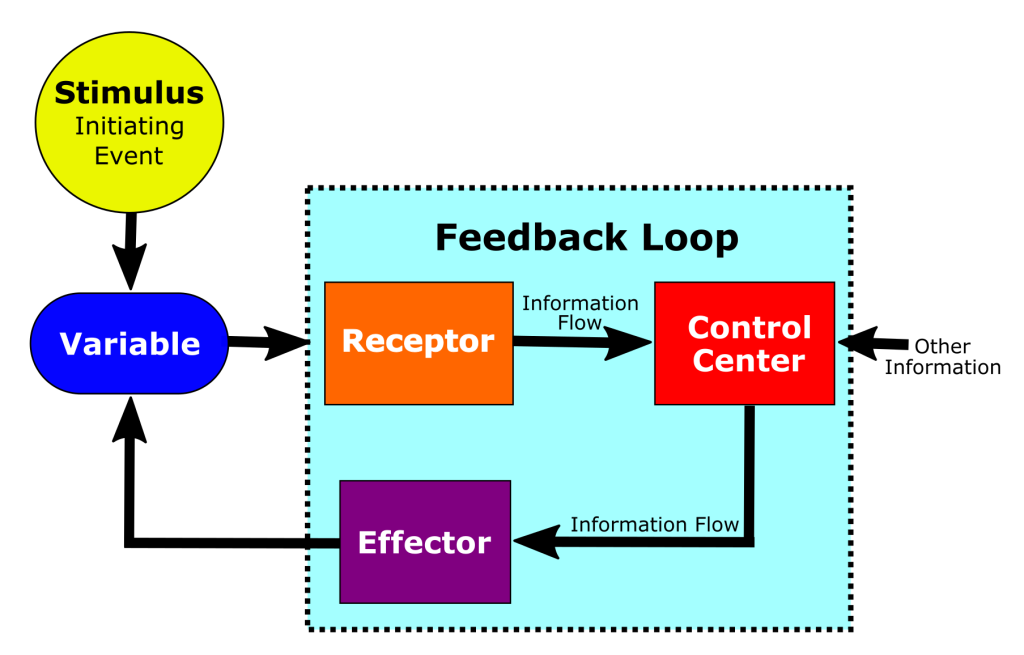
The maintenance of homeostasis in the body typically occurs through the use of feedback loops that control the body’s internal conditions. A feedback loop is a system used to manage the level of a variable in which there is a receptor (sensor), a control center (integrator or comparator), effectors (actors), and methods of communication.
We use the following terminology to describe feedback loops:
- Stimuli are factors in the internal or external environment that can alter homeostasis.
- Variables are parameters monitored and controlled or affected by the feedback system.
- Receptors (sometimes called sensors) detect changes in the variable affected by a stimulus.
- Control centers (sometimes called integrators) compare the variable to a set point and signal the effectors to generate a response. Control centers sometimes consider information other than just the level of the variable in their decision-making, such as time of day, age, external conditions, etc.
- A Set Point is the value that a variable varies around in a healthy individual.
- Effectors execute the necessary changes to adjust the variable.
- Responses are changes brought about by the effector(s).
- Methods of communication among the components of a feedback loop are necessary for it to function. This often occurs through nerves or hormones, but in some cases, receptors and control centers are the same structures, so there is no need for these signaling modes in that part of the loop.
Terminology in this area is often inconsistent. For example, there are cases where components of a feedback loop are not easily identifiable, but variables are maintained in a range. Such situations are still examples of homeostasis and are sometimes described as a feedback cycle instead of a feedback loop. A feedback cycle may be used in any situation in which a variable is regulated, and the level of the variable impacts the direction in which the variable changes (i.e., increases or decreases), even if there are not clearly identified loop components.
With this terminology in mind, homeostasis can be described as the totality of the feedback loops and feedback cycles the body uses to maintain itself in a state compatible with life.
Air conditioning is a technological system that can be as a feedback loop. The thermostat senses the temperature; an electronic interface compares the temperature against a set point (the temperature you want). If the temperature matches or is cooler, then nothing happens. If the temperature is too hot, the electronic interface triggers the air-conditioning unit to turn on. Once the temperature is lowered sufficiently to reach the set point, the electronic interface shuts the air-conditioning unit off. For this example, identify the steps of the feedback loop. 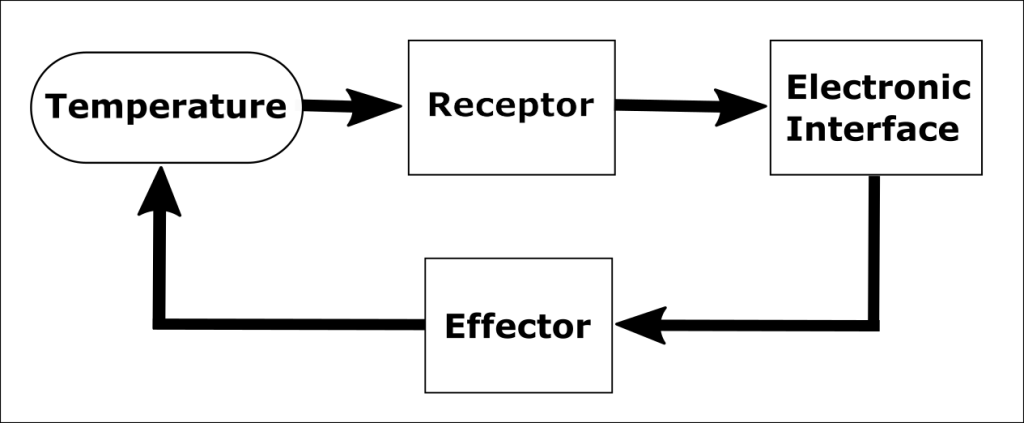
Look at the incomplete flowchart about the function of the air conditioning system, then choose which of the following gives the correct description of the missing steps.
- The thermometer is the receptor. The air conditioning unit is the effector.
Hint: Remember, the receptor senses the variable, in this case, the temperature. - The air conditioning unit is the receptor. The thermometer is the effector.
Hint: Remember, the effector creates a change that will modify the variable, in this case, temperature.
Cruise control is another example of a technological feedback system. The idea of cruise control is maintaining a constant speed in your car. The speedometer determines the car’s speed, and an electronic interface measures the car’s pace against a set point chosen by the driver. If the speed is too slow, the interface stimulates the engine; if the speed is too fast, the interface reduces the power to the tires.
Application of Terms to Temperature Homeostasis
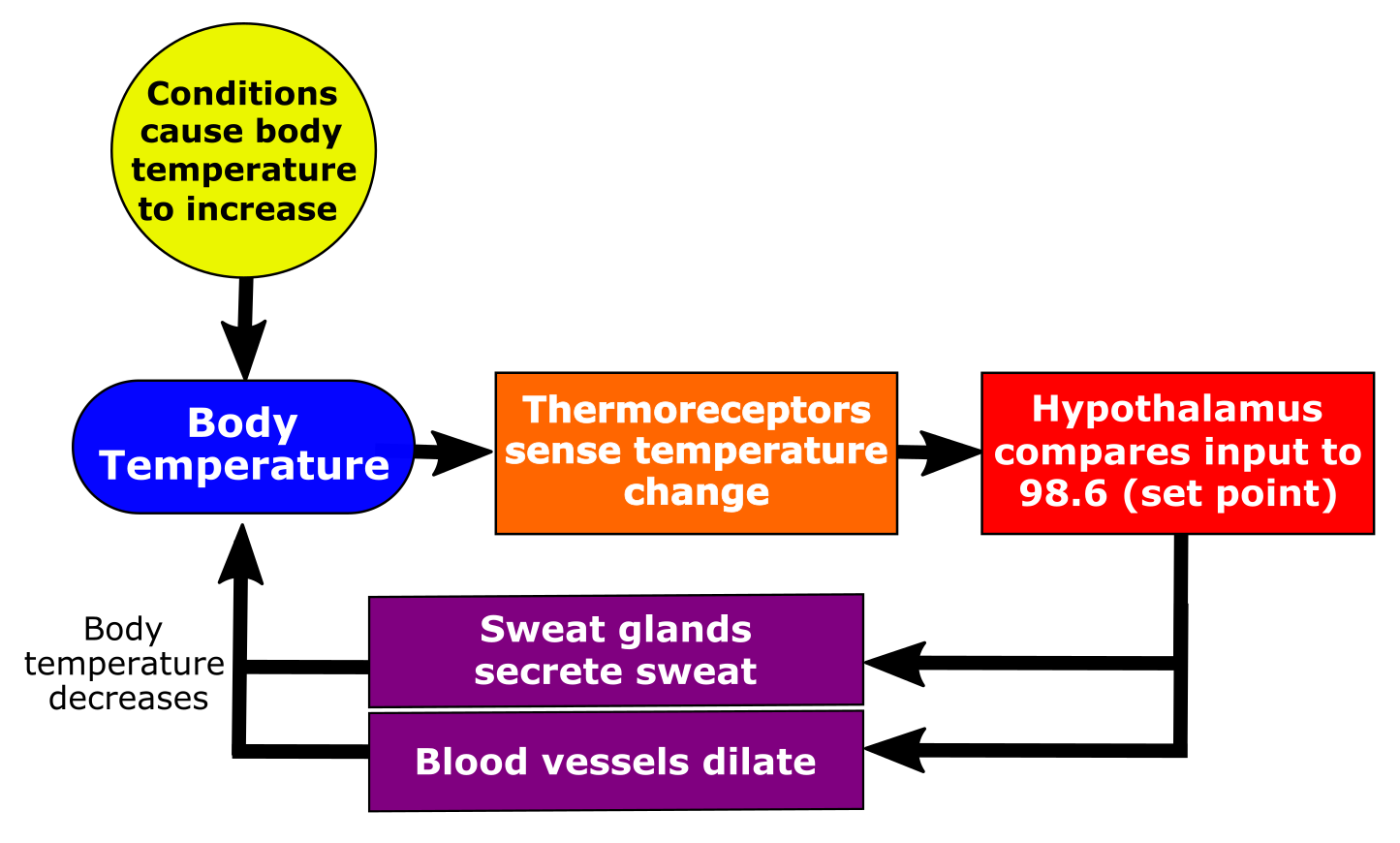
Consider one of the feedback loops that control body temperature.
- Variable: In this instance, the variable is body temperature.
- Stimulus: The stimulus, in this case, might be going outside when it is cold or hot.
- Receptors: Thermoreceptors detect changes in body temperature. For example, thermoreceptors in your internal organs can detect a lowered body temperature and produce nerve impulses that travel to the control center, the hypothalamus.
- Control Center: The hypothalamus controls a variety of effectors that respond to a decrease in body temperature.
- Effectors: The hypothalamus controls several effectors. Blood vessels near the skin constrict, reducing blood flow (and the resultant heat loss) to the environment. Skeletal muscles are also effectors in this feedback loop: they contract rapidly in response to decreased body temperature. This shivering helps to generate heat, which increases body temperature.
- Response: As shown in the figure, many parts of the body change how they function when we are exposed to stimuli that impact our body temperature.
Which two components of a feedback loop initiate a direct transfer of information?
- initiation event or stimulus and variable
- control center and effector
- effector and initiation event or stimulus
- variable and receptor
- receptor and control center
Which two components of a feedback loop directly cause changes to the variable?
- variable and receptor
- control center and effector
- effector and initiation event (stimulus)
- receptor and control center
- initiation event (stimulus) and variable
What is similar and different about a feedback loop or feedback cycle when describing a physiological process in the body?
Now compare your answers to our suggested answers. Apply the metacognitive cycle by evaluating the current status of your learning process and progress. Select one of the following:
- My answer is incorrect, or I didn’t know how to answer the question and just hit submit to see the answer. After reading the sample answer, I realize I need to learn more about the basic facts before I can apply and synthesize to explain this concept in my own words.
- My answer is incomplete or has some inaccurate parts. After reading the sample I realized I needed to review this content and use other strategies to understand the concepts before I could apply and synthesize them and explain them in my own words.
- My answer had some correct information. After reading the sample answer, I feel that I still need to use graphic organizational tools to practice applying and synthesizing the concepts to better explain them in my own words to the teacher or a fellow student.
- My answer is correct and comparable to the sample answer. I feel confident I can apply and synthesize the information I have learned to explain this concept in my own words to the teacher or a fellow student.
Feedback Loops and Homeostatic Regulation
Learning Objectives
- Compare and contrast positive and negative feedback in terms of the relationship between stimulus and response.
- Provide an example of a positive feedback loop. Describe the feedback loop’s specific structures (organs, cells, and their relationships.
- Provide an example of a negative feedback loop. Describe the feedback loop’s specific structures (organs, cells, and their relationships.
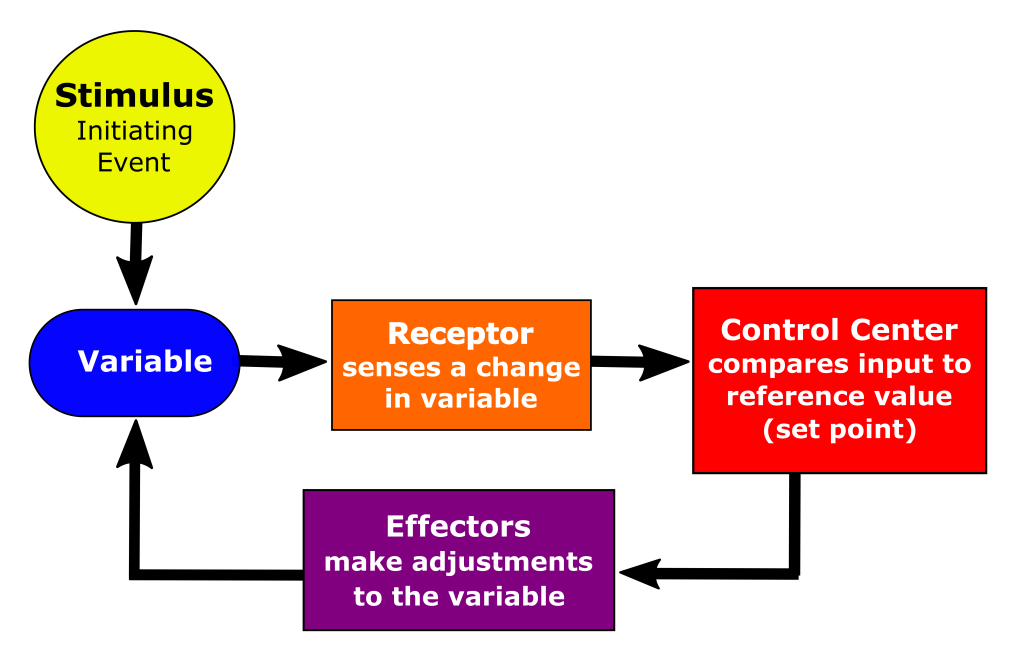
The adjusting of systems within a cell or body is called homeostatic regulation. Homeostasis should be considered a dynamic equilibrium within the organism rather than a constant, unchanging state. Homeostasis is an essential characteristic of living things. Major body systems act in ways that complement one another, allowing homeostasis.
Remember that homeostasis is the maintenance of a relatively stable internal environment. When a stimulus, or change in the environment, is present, feedback loops respond to keep systems functioning near a set point or ideal level. Feedback is a situation when the output or response of a loop impacts or influences the input or stimulus.
Typically, we divide feedback loops into two main types:
- Positive feedback loops, in which a change in a given direction causes an additional change in the same direction. For example, an increase in the concentration of a substance causes feedback that produces continued increases in concentration.
- Negative feedback loops, in which a change in a given direction causes a change in the opposite direction. For example, an increase in the concentration of a substance causes feedback that ultimately causes the concentration of the substance to decrease.
Positive feedback loops are inherently unstable systems. Because a change in input causes responses that produce continued changes in the same direction, positive feedback loops can lead to runaway conditions. The term positive feedback is typically used as long as a variable can amplify itself, even if the components of a loop (receptor, control center, and effector) are not easily identifiable. In most cases, positive feedback is harmful, but there are a few instances where positive feedback contributes to normal function when used in a limited fashion. For example, during blood clotting, a cascade of enzymatic proteins activates each other, forming a fibrin clot that prevents blood loss. One of the enzymes in the pathway called thrombin, not only acts on the next protein in the pathway but also can activate a protein that preceded it in the cascade. This last step leads to a positive feedback cycle, where an increase in thrombin leads to further increases in thrombin. (It should be noted that other aspects of blood clotting keep the overall process in check, such that thrombin levels do not rise without limit.) But, if we only consider the effects of thrombin on itself, it is considered a positive feedback cycle. Although some may consider this a positive feedback loop, such terminology is not universally accepted.
Negative feedback loops are inherently stable systems. Negative feedback loops, in conjunction with the various stimuli that affect a variable, typically produce a condition in which the variable oscillates around the set point. For example, negative feedback loops involving insulin and glucagon help to keep blood glucose levels within a narrow concentration range. The body releases insulin into the bloodstream if glucose levels get too high. Insulin causes the body’s cells to take in and store glucose, lowering the blood glucose concentration. If blood glucose gets too low, the body releases glucagon, which causes the release of glucose from some of the body’s cells.
Let’s take a closer look at one of the processes that happen when you exercise.
Your muscle cells use oxygen to convert the energy stored in glucose into the energy stored in ATP, which they then use to drive muscle contractions. When you exercise, your muscles need more oxygen. Therefore, to maintain an adequate oxygen level in all of the tissues in your body, you increase respiration rate and depth. This allows you to take in more oxygen. Your heart rate increases, which enables the delivery of more oxygenated blood to your muscles and other organs that need more oxygen.
- Draw a diagram that represents this feedback loop.
Hints: Consider using one of the diagrams in this chapter as a model.
Did I Get This? 2.3
Why is the process described above a negative feedback loop? Explain using the terms stimulus and set point.
Positive Feedback
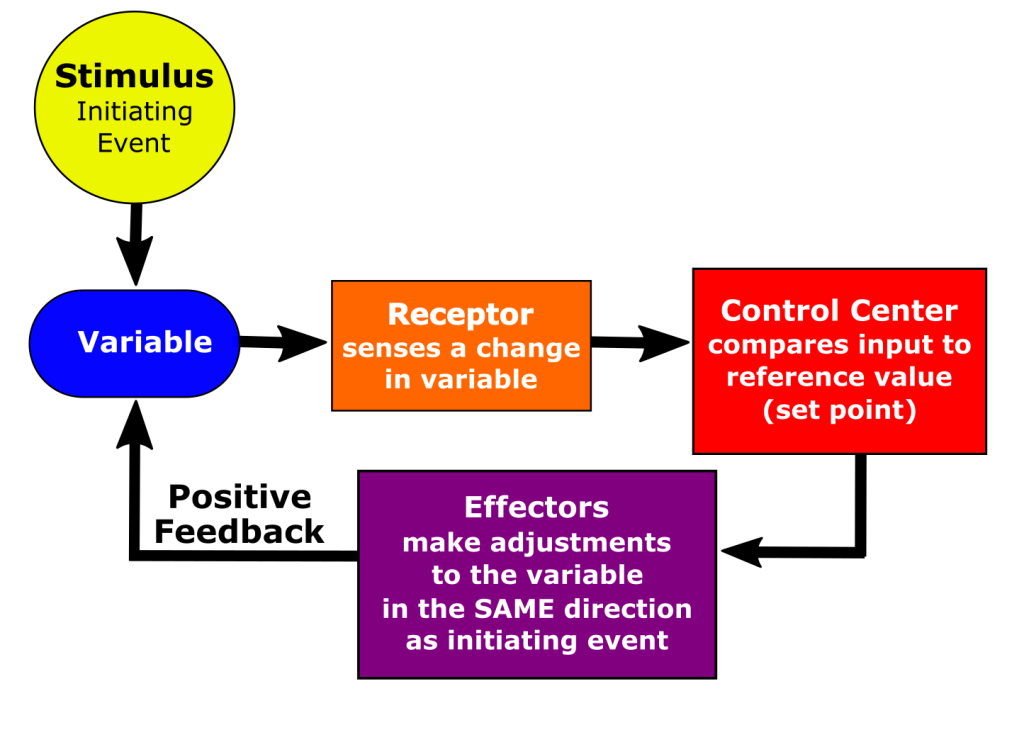
In a positive feedback mechanism, the output of the system stimulates the system in such a way as to increase the output further. Common terms that could describe positive feedback loops or cycles include “snowballing” and “chain reaction.” Without a counter-balancing or “shut-down” reaction or process, a positive feedback mechanism has the potential to produce a runaway process. As noted, some physiologic processes are commonly considered positive feedback, although they may not all have identifiable components of a feedback loop. In these cases, the positive feedback loop always ends with counter-signaling that suppresses or removes the original stimulus.
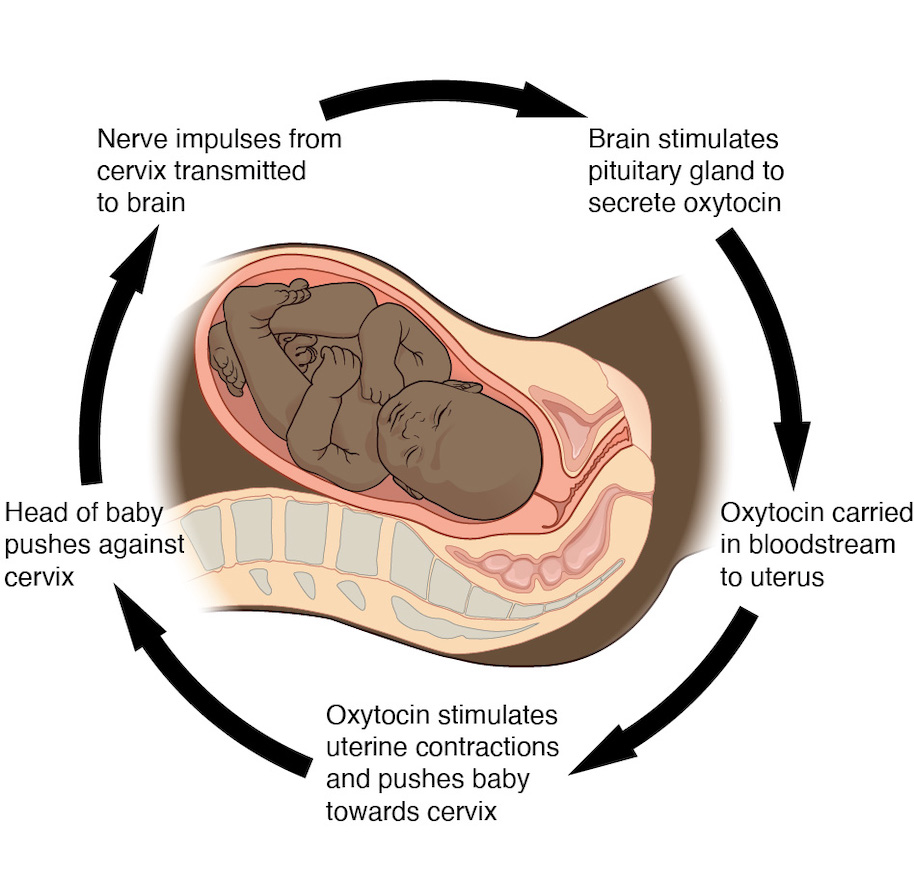
An excellent example of positive feedback involves the amplification of labor contractions. The contractions begin as the baby moves into position, stretching the cervix beyond its normal position. The feedback increases the strength and frequency of the contractions until the baby is born. After birth, the stretching stops, and the loop is interrupted. Thus, normal childbirth is driven by a positive feedback loop. A positive feedback loop results in a change in the body’s status rather than a return to homeostasis. The response, however, eventually results in the removal of the stimulus.
Another example of positive feedback during the milk let-down reflex. As the baby feeds, its suckling stimulates the breast, promoting the release of the hormone oxytocin from the brain. This leads to the contraction of the smooth muscle cells of the breast ducts. As a result, milk is ejected into the baby’s mouth. The positive feedback loop between suckling, oxytocin release, muscle contraction, and milk ejection continues until the baby finishes feeding. The response in this case leads to the removal of the stimulus once the baby is satiated.
Oxytocin is also involved in the release of milk, more commonly known as milk letdown. Look at the incomplete flowchart and identify which choice correctly shows the missing steps.
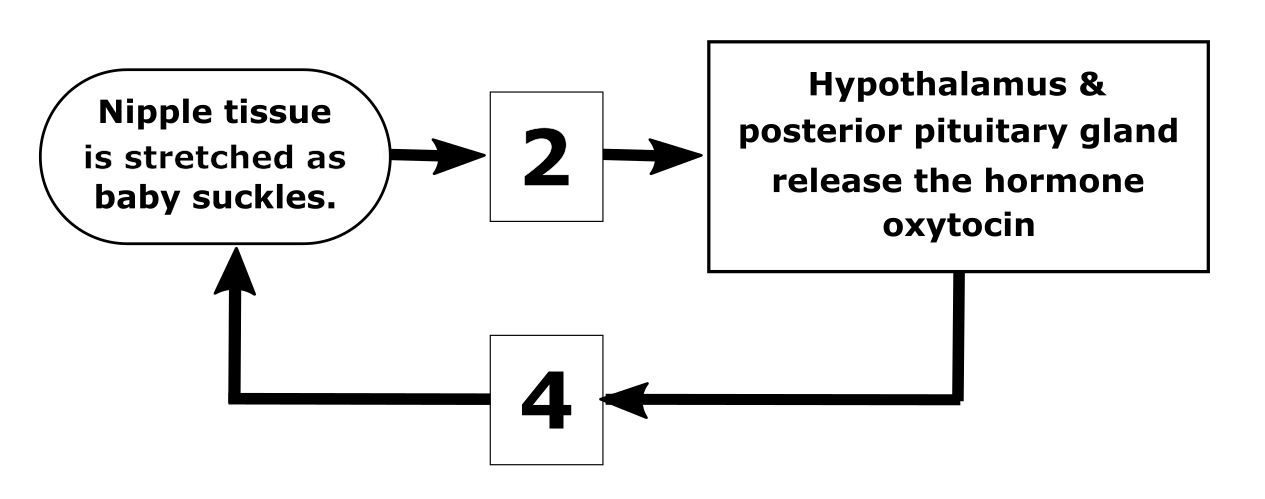
- 2 = Receptors in nipple tissue detect stretch; 4 = Increased contractions stretch nipple tissue and release milk from mammary glands.
- 4 = More milk is produced, 2 = Baby suckles more.
Hint: Remember, we are interested in how the cycle continues after it is established.
Beneficial positive feedback mechanisms are self-limiting; the positive feedback loop eventually leads to the removal of the stimulus. The examples above provide examples of beneficial positive feedback mechanisms. However, in most instances, positive feedback damages life processes since it prevents a return to homeostasis. For example, blood pressure can fall significantly if a person loses a lot of blood due to trauma. Blood pressure is a regulated variable. If blood pressure drops, the heart increases its rate and contracts more strongly. These changes to the heart cause it to need more oxygen and nutrients, but if the blood volume in the body is too low, the heart tissue itself will not receive enough blood flow to meet these increased needs. The imbalance between the oxygen demands of the heart and oxygen supply can lead to further heart damage, which lowers blood pressure, providing a more significant change in the variable (blood pressure). The loop responds by trying to stimulate the heart even more strongly, leading to further heart damage. The loop goes on until death ensues.
Negative Feedback
Most biological feedback systems are regulated by negative feedback loops. Negative feedback occurs when a system’s output acts to reduce or dampen the processes that lead to the output of that system, resulting in less output. Thus, negative feedback allows systems to self-stabilize. Negative feedback is a vital control mechanism for the body’s homeostasis.
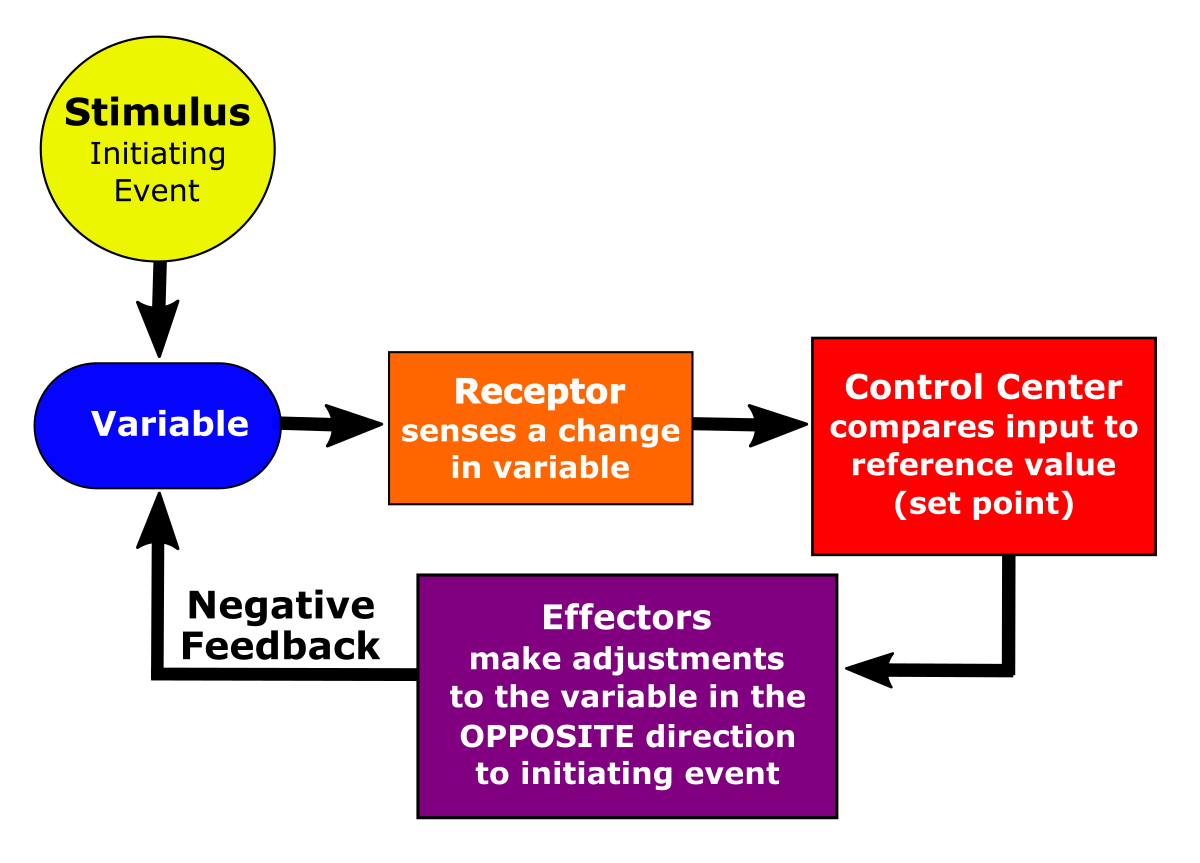
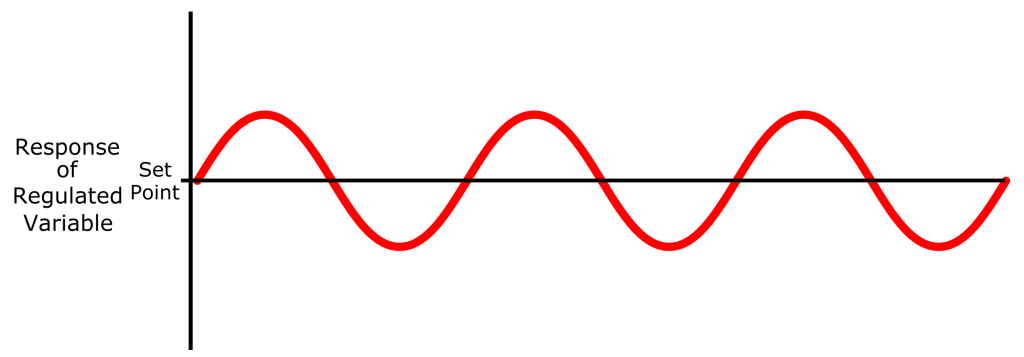
Figure 2.7 shows a generic negative feedback loop. A more dynamic way of considering negative feedback is shown in Figure 2.8. The horizontal line represents the set point for a variable regulated by negative feedback. The curving line represents changes in the variable around the set point.
Example: Temperature Homeostasis
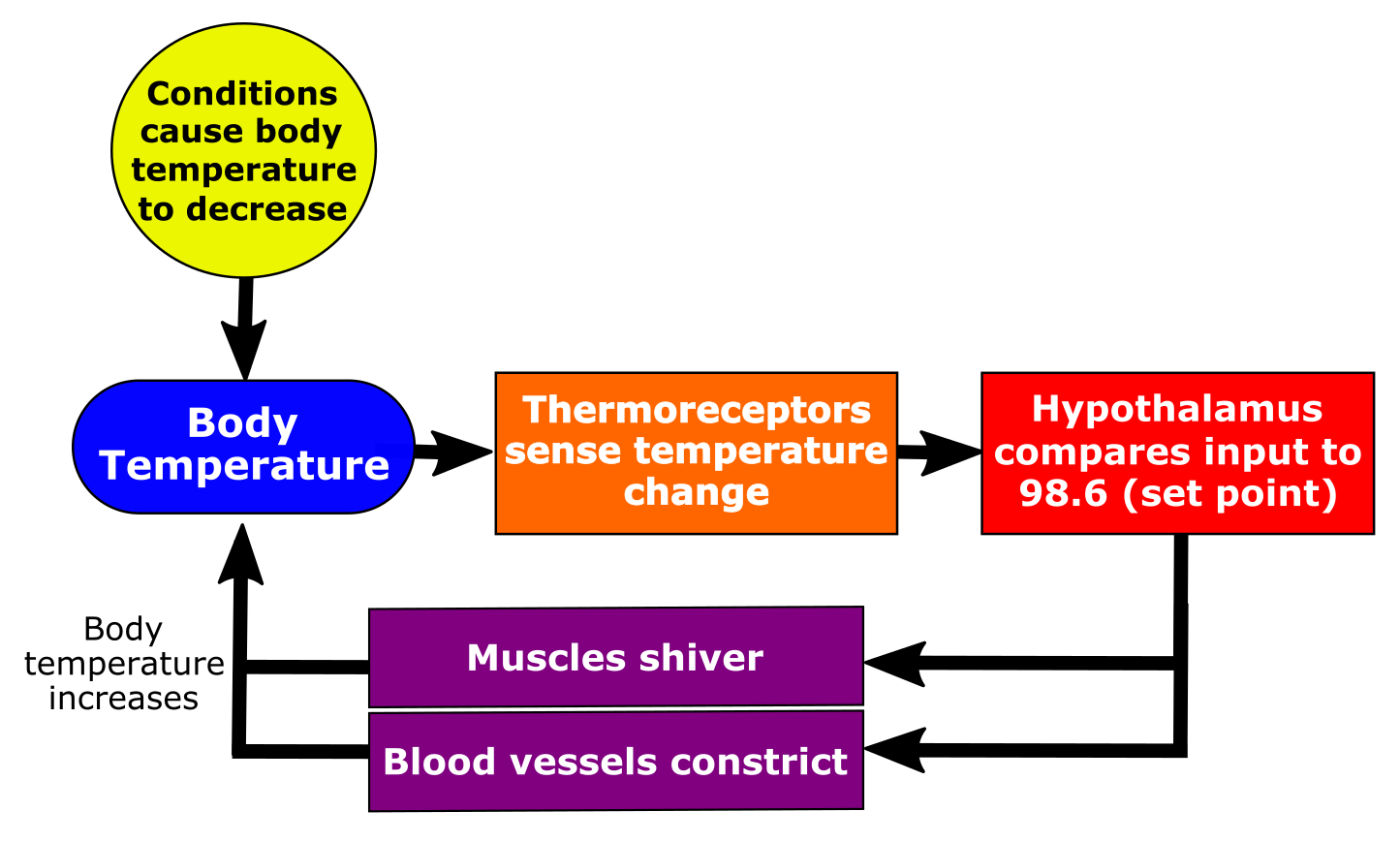
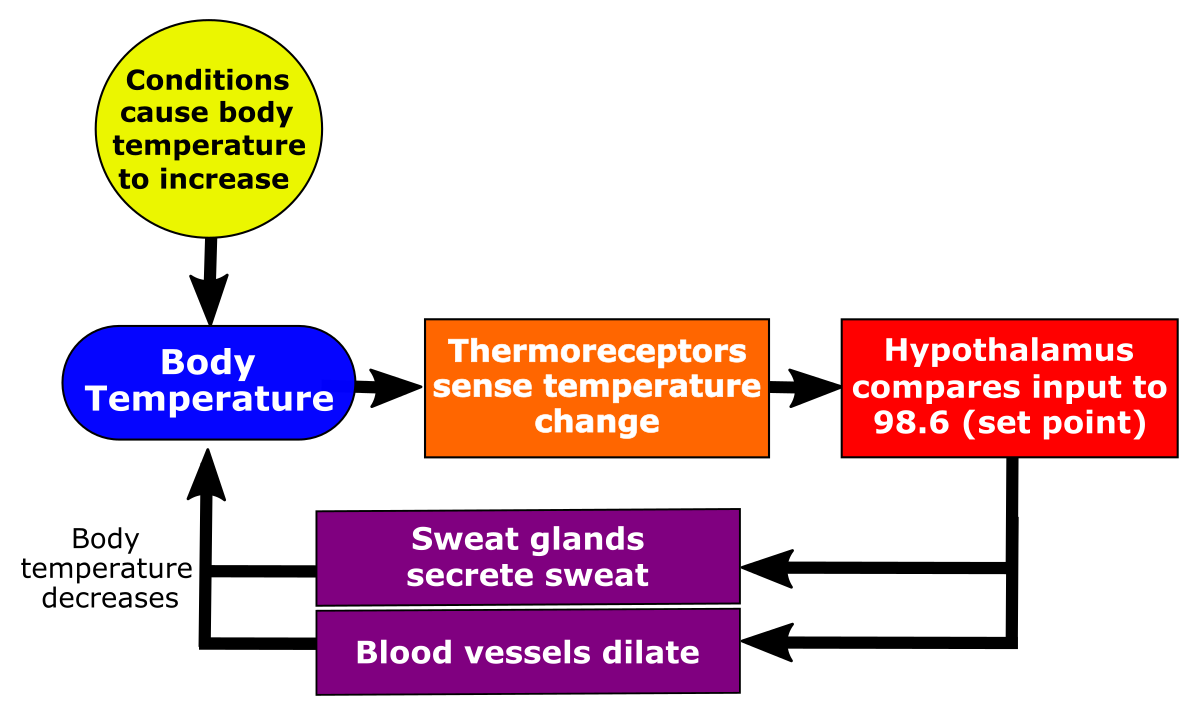
You saw an example of a feedback loop applied to temperature and identified the components involved. This is an important example of how a negative feedback loop maintains homeostasis. The body maintains a relatively constant internal temperature to optimize chemical processes. Neural impulses from heat-sensitive thermoreceptors in the body signal the hypothalamus. The hypothalamus, located in the brain, compares the body temperature to a set point value.When body temperature drops, the hypothalamus initiates several physiological responses to increase heat production and conserve heat:
- Narrowing of surface blood vessels (vasoconstriction) decreases the flow of heat to the skin.
- Shivering begins, increasing the production of heat by the muscles.
- Adrenal glands secrete stimulatory hormones such as norepinephrine and norepinephrine to increase metabolic rates and hence heat production.
These effects cause body temperature to increase. When it returns to normal, the hypothalamus is no longer stimulated, and these effects cease.
When body temperature rises, the hypothalamus initiates several physiological responses to decrease heat production and lose heat:
- Widening of surface blood vessels (vasodilation) increases the flow of heat to the skin.
- Sweat glands release water (sweat) and evaporation cools the skin.
These effects cause body temperature to decrease. When it returns to normal, the hypothalamus is no longer stimulated, and these effects cease.
Many homeostatic mechanisms, like temperature, have different responses if the variable is above or below the set point. When temperature increases, we sweat, when it decreases, we shiver. These responses use different effectors to adjust the variable. In other cases, a feedback loop will use the same effector to adjust the variable back toward the set point, whether the initial change of the variable was either above or below the set point. For example, pupillary diameter is adjusted to make sure an appropriate amount of light is entering the eye. If the amount of light is too low, the pupil dilates, if it is too high, the pupil constricts.
This might be compared to driving. If your speed is above the set point (the value you want it to be), you can either just decrease the level of the accelerator (i.e. coast), or you can activate a second system — the brake. In both cases, you slow but it can be done by either just “backing” off on one system or adding a second system.
Homeostatic Maintenance
Learning Objectives:
- Predict the types of problems that would occur if homeostasis could not be maintained.
- Describe how abnormalities in homeostatic feedback loops lead to disease states.
| Negative Feedback | Positive Feedback | |
| Example | Regulation of blood glucose, pH, calcium, pressure, or body temperature | Normal childbirth, lactation, blood clotting |
| Response | Reverses a change in a physiological condition | Intensifies a change in physiological condition |
| Result | Return to a set point | Reach an endpoint |
| Overall | Provides stability | Accelerates a process to completion |
You have read about general and specific examples of homeostasis, including positive and negative feedback, and have learned the terminology that is used to describe parts of the feedback loops. It is essential to become comfortable with the terminology since it will be used to introduce new concepts in upcoming sections of this text. Table 2.1 compares positive and negative feedback.
Maintaining homeostasis within the body is important for proper physiological function. It is important to recognize the mechanisms of homeostasis in the body, as well as the consequences of homeostasis dysfunction. As examples, we will explore how the body maintains tight control over blood Calcium levels and over cell number. The details of these processes are not important to memorize at this point. Rather, focus on applying what you’ve learned in this chapter
Blood Calcium Levels
Body functions such as regulation of the heartbeat, contraction of muscles, activation of enzymes, and cellular communication require tightly regulated calcium levels. Normally, we get a lot of calcium from our diet. The small intestine absorbs calcium from digested food.
The endocrine system is the control center for regulating blood calcium homeostasis. The parathyroid and thyroid glands contain receptors that respond to levels of calcium in the blood. In this feedback system, blood calcium level is the variable, because it changes in response to the environment. Changes in blood calcium level have the following effects:
- When blood calcium is low, the parathyroid gland secretes parathyroid hormone. This hormone causes effector organs (the kidneys and bones) to respond. The kidneys prevent calcium from being excreted in the urine. Specialized cells in bones break down bone tissue and release calcium. When blood calcium levels are high, less parathyroid hormone is released. Parathyroid hormone is the main controller of blood plasma calcium levels in adults.
- Children have a second hormone that contributes to calcium regulation, called calcitonin. It is released from the thyroid gland when blood calcium levels are high. Calcitonin prevents bone breakdown and causes the kidneys to allow excess calcium to be removed from the body in urine.
Calcium imbalance in the blood can lead to disease or even death. Hypocalcemia refers to low blood calcium levels. Signs of hypocalcemia include muscle spasms and heart malfunctions. Hypercalcemia occurs when blood calcium levels are higher than normal. Hypercalcemia can also cause heart malfunction as well as muscle weakness and kidney stones.
Control of Cell Number
Although homeostasis is often carried out by a negative feedback loop with an identifiable receptor, control center, and effectors, it more broadly means maintaining variables in a range suitable for optimal function. This includes the regulation of cell number in our tissues so that we don’t have too few or too many. It may be hard to identify specific components of a feedback loop in this case, but it is clear that there are at least negative feedback cycles that help maintain cell numbers. This negative feedback is known to occur through communications between neighboring cells and an ability to sense the levels of nutrients in the area they are growing. Normally cells will stop dividing when there is an appropriate number of cells in a tissue or space. If a neighboring cell is lost or if there is an inadequate number of cells, cells may be stimulated to divide, a process called proliferation. Too many neighbors trigger an internal response that leads to death in a regulated programmed way called apoptosis. When cells sense they have no neighbors, signals in the nucleus cause division of the cell.
Learn By Doing 2.5: Homeostatic Maintenance of Calcium and Cell Number
Based on the above description of calcium homeostasis with parathyroid hormone, try to answer these questions without referring to the feedback loop diagram.
What is the variable being controlled by the feedback loop?
Hint: What is being monitored and needs to be adjusted in this example?
- calcium in urine
- parathyroid gland
- parathyroid hormone
- blood calcium levels
What is the receptor?
Hint: What senses the change in blood calcium levels?
- Kidney
- parathyroid gland
- parathyroid hormone
- blood calcium levels
What is the control center?
Hint: What compares the current calcium level to the set point in order to adjust calcium levels?
- Kidney
- parathyroid gland
- parathyroid hormone
- blood calcium levels
What is the effector?
Hint: Effectors tend to have the most direct effects on the variables.
- Kidney
- parathyroid gland
- parathyroid hormone
- blood calcium levels
Using the above description of the regulation of cell number, try to answer these questions to apply the feedback cycle concept.
What would be comparable to a variable in this scenario?
Hint: What is being monitored and needs to be adjusted in this example?
- Cells
- number of cells
- proliferation or apoptosis
- cell-to-cell connections
- internal and nuclear signals
What is functioning as the receptor, detecting changes in the environment?
Hint: What “senses” the environment?
- Cells
- number of cells
- proliferation or apoptosis
- cell-to-cell connections
- internal and nuclear signals
What acts as the control center?
Hint: Where is information being processed?
- Cells
- number of cells
- proliferation or apoptosis
- cell-to-cell connections
- internal and nuclear signals
Predict the type of problem that would occur if cell number is not regulated.
Integration of Systems
Learning Objectives
Each organ system performs specific functions for the body, and each organ system is typically studied independently. However, the organ systems also work together to help the body maintain homeostasis.
For example, the cardiovascular, urinary, and lymphatic systems all help the body control water balance. The cardiovascular and lymphatic systems transport fluids throughout the body and help sense both solute and water levels and regulate pressure. If the water level gets too high, the urinary system produces more dilute urine (urine with higher water content) to help eliminate the excess water. If the water level gets too low, more concentrated urine is produced so that water is conserved. The digestive system also plays a role in variable water absorption. Water can be lost through the integumentary and respiratory systems, but that loss is not directly involved in maintaining body fluids and is usually associated with other homeostatic mechanisms.
Similarly, the cardiovascular, integumentary, respiratory, and muscular systems work together to help the body maintain a stable internal temperature. If body temperature rises, blood vessels in the skin dilate, allowing more blood to flow near the skin’s surface. This allows heat to dissipate through the skin and into the surrounding air. The skin may also produce sweat if the body gets too hot; when the sweat evaporates, it helps to cool the body. Rapid breathing can also help the body eliminate excess heat. Together, these responses to increased body temperature explain why you sweat, pant, and become red in the face when you exercise hard. (Heavy breathing during exercise is also one way the body gets more oxygen to your muscles, and gets rid of the extra carbon dioxide produced by the muscles.)
Conversely, if your body is too cold, blood vessels in the skin contract, and blood flow to the extremities (arms and legs) slows. Muscles contract and relax rapidly, which generates heat to keep you warm. The hair on your skin rises, trapping more air, which is a good insulator, near your skin. These responses to decreased body temperature explain why you shiver, get “goose bumps,” and have cold, pale extremities when you are cold.
Development of a fever is an interesting situation. Although it may appear that fever is caused by a disrupted feedback loop, it is actually a situation in which the temperature set point of the body changes and the feedback loop continues to operate normally. This causes body temperature to increase similar to the way that the temperature in your home will increase if you turn up the thermostat.
In extreme cases, a fever can be a medical emergency; but fever is an adaptive physiological response of our body to certain infectious agents. Pyrogens are molecules that cause the temperature set point to change. These pyrogens can come from microorganisms that infect you, or they can be produced by your body cells in response to an infection of some sort.
Learn By Doing 2.6: Using Multiple Systems to Maintain Homeostasis
For the paragraph below, fill in blanks 1, 2, and 3 from columns 1, 2, and 3 in the table.
| 1 | 2 | 3 |
| a variable | sweat glands and increased skin blood flow | sweat glands and increased skin blood flow |
| the control center | skeletal muscles to shiver and decrease skin blood flow | skeletal muscles to shiver and decrease skin blood flow |
| information impacting the control center | ||
| an effector | ||
In the example described above, the pyrogens would be considered _____1_____. Because the set point has been increased, you now feel cold at the “normal” body temperature. In response, as the temperature rises, instead of stimulating _____2_____ as effectors to cool off the body, the hypothalamus will start stimulating _____3______ as effectors to reach the new upper temperature set point.
Hint: The components of a feedback loop do not change. Take another look at a feedback loop diagram in this module and pay attention to a source of multiple information input to the control center.
*
“Learn By Doing” and “Did I Get This?” Feedback
Did I Get This? 2.1
Homeostasis allows us to:
- Jump over a piece of broken glass when we see it.
Incorrect. This is an example of a conscious response to an environmental cue. Although this reaction might prevent our body from having to take steps to regulate the internal state (if we allowed a cut to happen), it is not an example of homeostasis by itself. - Increase our blood pressure when we are stressed.
- Incorrect. Regulating blood pressure near a constant value is an example of how the body homeostasis occurs. But when blood pressure increases away from the target value, this is not an example of homeostasis, but an example of a process that disrupts homeostasis.
- Maintain our blood sodium levels after eating a bag of salty pretzels.
Correct. Regulating blood sodium levels is critical to the function of cells within the body. Therefore, there are body systems that regulate this value, even when challenged by a high amount of salt in the diet. - Hit a baseball when it is pitched to us.
Incorrect. This is an example of a learned motor response (reflex), which does not have to do with regulating our internal environment.
Describe how each of the following levels of organization contribute to homeostasis of cellular ATP levels during exercise.
- Cellular
OUR ANSWER: Although there are many correct answers, one example would be those chemical reactions that regulate the amount of ATP within the cell. Certain enzymes in the enzymatic pathway for making ATP will be inhibited when ATP levels are high (called feedback inhibition), while these same enzymes will not be inhibited when ATP is low. Exercise stimulates the use in ATP and a de-inhibition of these enzymes in order to maintain ATP levels within the cell.
- Organ (in this case a whole muscle)
OUR ANSWER: One way that a whole muscle can maintain ATP levels during exercise is to affect the amount of blood flow to the organ. Local tissues/organs are important regulators of flow to themselves, releasing chemicals that constrict or dilate the blood vessels that feed the organs. In the case of exercise, blood flow to muscles can increase significantly, providing the oxygen and glucose necessary for ATP production.
- Organ Systems
OUR ANSWER: In order to maintain ATP levels in the muscles during exercise, the muscles need to obtain an increased level of blood flow. The muscles themselves contribute by dilating the blood vessels that feed them, but this must be matched by an increase in cardiac output from the heart. Therefore the heart increased cardiac output, often from a resting state near 5 liters/min to a value near 15 L/min.
Now compare your answers to our suggested answers. Apply the metacognitive cycle by evaluating the current status of your learning process and progress. Select one of the following:
- My answer is incorrect or I didn’t know how to answer the question and just hit submit to see the answer. After reading the sample answer, I realize I need to learn more about the basic facts before I can apply and synthesize to explain this concept in my own words.
Great! Now that you have evaluated your performance, how might your change your study habits as a result? - My answer is incomplete and/or has some inaccurate parts. After reading the sample answer, I realize I need to review this content and use other strategies to understand the concepts before I can apply and synthesize to explain it in my own words.
Great! Now that you have evaluated your performance, how might your change your study habits as a result? - My answer had some correct information. After reading the sample answer, I feel that I still need to use graphic organizational tools to practice applying and synthesizing the concepts to better explain them in my own words to the teacher or a fellow student.
Great! Now that you have evaluated your performance, how might your change your study habits as a result? - My answer is correct and comparable to the sample answer.I feel confident I can apply and synthesize the information I have learned to explain this concept in my own words to the teacher or a fellow student.
Great job!
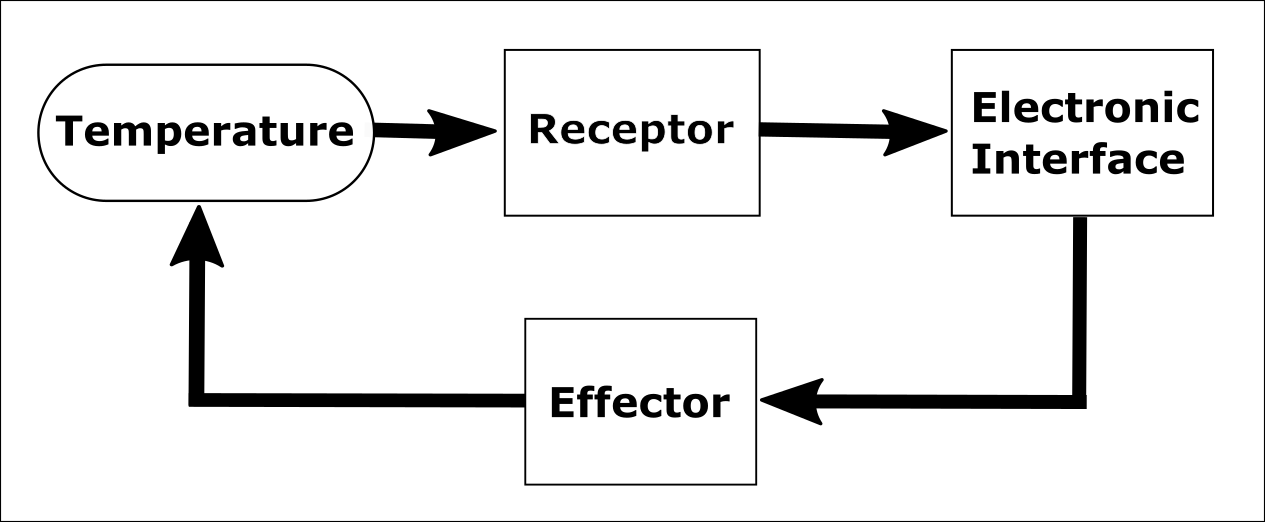
- The thermometer is the receptor. The air conditioning unit is the effector.
Correct. The thermometer is the receptor that detects the change and the air conditioning unit is the effector and changes the temperature. - The air conditioning unit is the receptor. The thermometer is the effector.
Incorrect. The air conditioning unit will actually change the temperature which means it is not a receptor.
Let’s take a closer look at one of the processes that happen when you exercise.
Your muscle cells use oxygen to convert the energy stored in glucose into the energy stored in ATP, which they then use to drive muscle contractions. When you exercise, your muscles need more oxygen. Therefore, to maintain an adequate oxygen level in all of the tissues in your body, you increase respiration rate and depth. This allows you to take in more oxygen. Your heart rate increases, which enables the delivery of more oxygenated blood to your muscles and other organs that need more oxygen.
- Draw a diagram that represents this feedback loop.
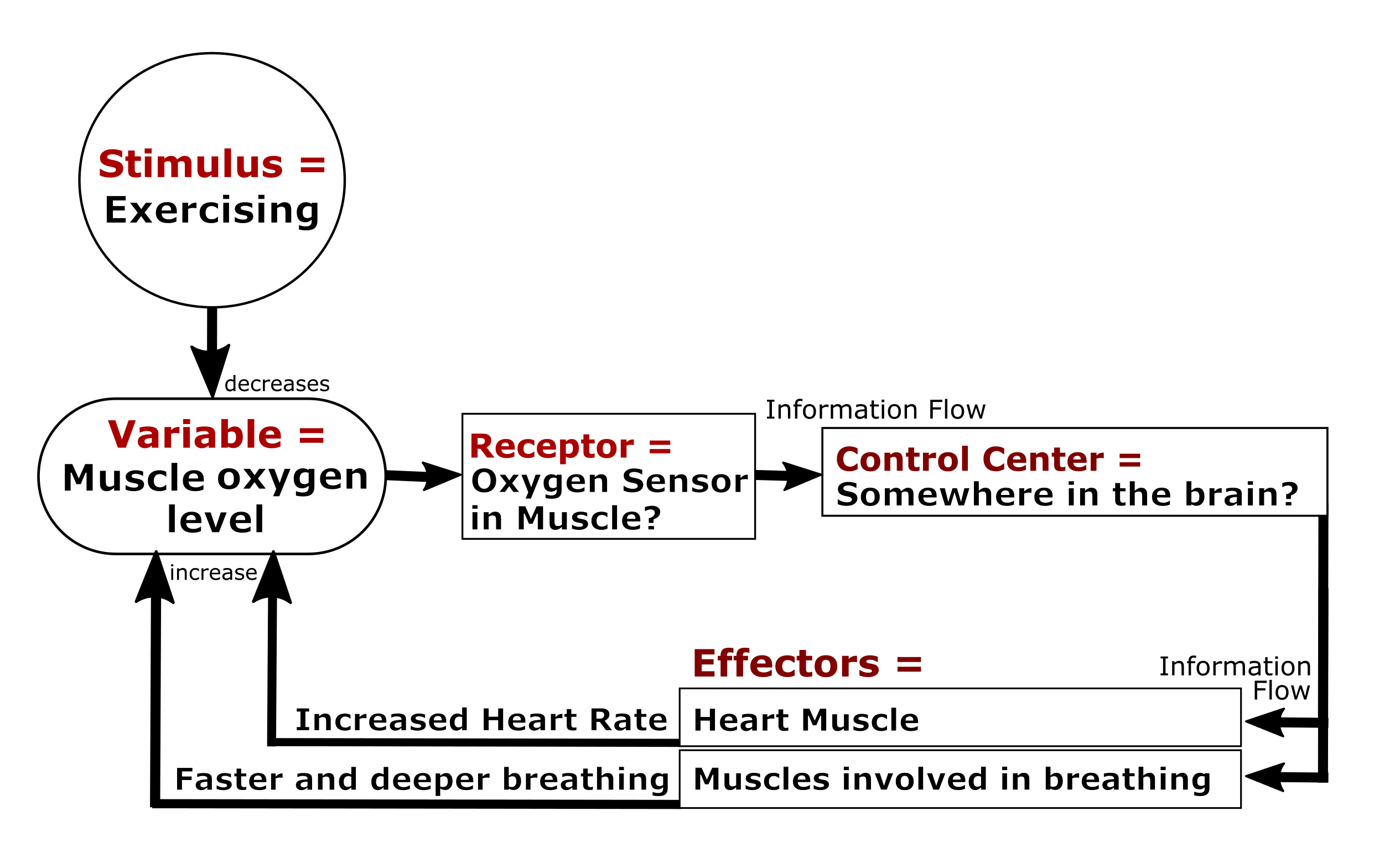
- Why is the process described above a negative feedback loop? Explain using the terms stimulus and set point.
This is an example of a negative feedback loop because the body is maintaining a set level of oxygen in the bloodstream. As the muscles use the available blood oxygen (stimulus), the body works to replace this oxygen by breathing in more oxygen (increased intake) and transporting it more quickly throughout the entire body (quickened heartbeat). This system is inherently stable because when you modify your exercise, your body modifies its responses to maintain a set level of oxygen available to all tissues in the body.
Which two components of a feedback loop initiate a direct transfer of information?
- initiation event or stimulus and variable
Incorrect. The stimulus can change the variable, but neither is sending information for the feedback loop. - control center and effector
Incorrect. These can change the variable but are not sending information for the feedback loop. - effector and initiation event or stimulus
Incorrect. These can change the variable but are not sending information for the feedback loop. - variable and receptor
Incorrect. The receptor communicates information about changes in the variable, but the variable itself is not communicating in the feedback loop. - receptor and control center
Correct. The receptor communicates with the control center about changes in the variable and the control center communicates with the effector to initiate adjustments.
Which two components of a feedback loop will be directly causing changes to the variable?
- variable and receptor
Incorrect. The receptor is monitoring the change in the variable, but the variable can’t change itself. - control center and effector
Incorrect. The control center will communicate with the effector for regulation, but will not directly cause a change in the variable. - effector and initiation event (stimulus)
Correct. An increase or decrease in the variable can be caused by both the initiating event and an effector. - receptor and control center
Incorrect. The receptor is monitoring the change in the variable and communicating with the control center, but not causing the change. - initiation event (stimulus) and variable
Incorrect. The initiating event can increase or decrease the variable, but the variable can’t change itself.
What is similar and different about a feedback loop or feedback cycle when describing a physiological process in the body?
OUR ANSWER: They both maintain a variable in the body within a range to create a stable internal environment for proper function. A feedback loop involves clearly identified receptor, control center, and effector to maintain the variable, while it may not be easy to identify all the components in a feedback cycle. Sometimes the same structure may include the receptor and the control center so there is no communication for that part of the loop, but the level of a variable is still regulated.
Now compare your answers to our suggested answers. Apply the metacognitive cycle by evaluating the current status of your learning process and progress. Select one of the following:
- My answer is incorrect or I didn’t know how to answer the question and just hit submit to see the answer. After reading the sample answer, I realize I need to learn more about the basic facts before I can apply and synthesize to explain this concept in my own words.
Great! Now that you have evaluated your performance, how might your change your study habits as a result? - My answer is incomplete and/or has some inaccurate parts. After reading the sample answer, I realize I need to review this content and use other strategies to understand the concepts before I can apply and synthesize them to explain them in my own words.
Great! Now that you have evaluated your performance, how might your change your study habits as a result? - My answer had some correct information. After reading the sample answer, I feel that I still need to use graphic organizational tools to practice applying and synthesizing the concepts to better explain them in my own words to the teacher or a fellow student.
Great! Now that you have evaluated your performance, how might your change your study habits as a result? - My answer is correct and comparable to the sample answer.I feel confident I can apply and synthesize the information I have learned to explain this concept in my own words to the teacher or a fellow student.
Great job!
Oxytocin is also involved in the release of milk, more commonly known as milk letdown. Look at the incomplete flowchart and identify which choice correctly shows the missing steps.
- 2 = Receptors in nipple tissue detect stretch; 4 = Increased contractions stretch nipple tissue and release milk from mammary glands.
Correct. The contractions of the mammary ducts not only release the milk to the baby, they also stimulate the nipple receptors to amplify the effect. - 4 = More milk is produced, 2 = Baby suckles more.
Incorrect. There needs to be a receptor between the variable and the control center and the baby is not the effector. Prolactin would be the hormone involved in controlling milk production, not oxytocin. Review oxytocin’s role in childbirth.
Learn By Doing 2.4: Analyzing Homeostatic Feedback Loops
Read the following text then use the information to complete the questions.
Blood moving through our bodies pushes against the walls of our blood vessels. This is called blood pressure. It is generated by the contraction of the heart. Changes in the strength and rate of contraction increase blood pressure. Changes in the volume of blood are also directly related to changes in blood pressure. A decrease in the diameter of the vessels that blood travels through will have an inverse effect on blood pressure. Blood pressure homeostasis involves receptors monitoring blood pressure and control centers that initiate changes in the effectors to keep it within a normal range.
For the paragraph below, fill in blanks 1, 2, 3, and 4 with either increase or decrease.
First, predict how changes in both heart rate and blood vessel diameter will affect blood pressure. As the heart rate increases, we would expect the blood pressure to –1– and as the heart rate decreases, we would expect the blood pressure to –2– . As the blood vessels in the body constrict (decrease in diameter), we would expect the blood pressure to –3– and as the blood vessels in the body dilate (increase in diameter), we would expect the blood pressure to –4– .
For the paragraph below, fill in blanks 1 and 2 with one of the following: control center, variable, effector, and receptor. Fill in blanks 3 through 7 with either increase or decrease.
Blood pressure is the –1– of this homeostatic feedback loop. It is monitored by baroreceptors in certain blood vessels. A change in blood pressure causes baroreceptors to send impulses to the brainstem. The brainstem compares input to the set point and functions as the –2– of the homeostatic feedback loop.
An increase in blood pressure causes the brainstem to send signals via a set of nerve cells going to the heart, where they release a chemical called acetylcholine. To counteract this increase in blood pressure, acetylcholine causes the heart rate to –3–, bringing the blood pressure back down. Conversely, if blood pressure drops below the set point, the cardiovascular center sends signals via neurons going to the heart to release norepinephrine, also known as noradrenaline. Norepinephrine has the opposite effect of acetylcholine, causing the heart rate to –4–, bringing the blood pressure back up.
At the same time, a drop in blood pressure will stimulate the brainstem to direct the release of norepinephrine to some blood vessels, which causes them to constrict, causing the blood pressure to –5–. A return to the normal rate of norepinephrine release allows the blood vessels to return to normal diameter and blood pressure usually returns back to normal.
Another negative feedback loop regulates blood pressure by using the kidneys to regulate fluid levels in the body. If the kidneys excrete more fluid from the body, it causes the total volume of body fluids such as blood to decrease. As the blood volume falls, blood pressure would –6– . If the kidneys were stimulated to conserve more fluid in the body, that could cause the volume of blood to increase, and blood pressure could –7– .
Learn By Doing 2.5: Homeostatic Maintenance of Calcium and Cell Number
Based on the above description of calcium homeostasis with parathyroid hormone, try to answer these questions without referring to the feedback loop diagram.
What is the variable being controlled by the feedback loop?
Hint: What is being monitored and needs to be adjusted in this example?
- calcium in urine
Incorrect. Urination is one way for the effector to get rid of any excess variable, but it is not the variable that is being monitored and regulated. - parathyroid gland
Incorrect. The parathyroid gland is involved in responding to changes in this variable. The variable is an ion whose concentrations can change. - parathyroid hormone
Incorrect. The parathyroid hormone is a chemical used to communicate with the effectors. - blood calcium levels
Correct. Proper blood calcium level is important for many body functions.
What is the receptor?
Hint: What senses the change in blood calcium levels?
- Kidney
Incorrect. The kidneys play a role in conserving or excreting calcium but are not the receptor monitoring the level of blood calcium. - parathyroid gland
Correct. In this case, the cells of the parathyroid glands monitor calcium levels, just like the cells of the pancreas monitor blood glucose levels. - parathyroid hormone
Incorrect. The parathyroid hormone is a chemical used to communicate with the effectors. - blood calcium levels
Incorrect. Blood calcium is the variable being regulated.
What is the control center?
Hint: What compares the current calcium level to the set point in order to adjust calcium levels?
- Kidney
Incorrect. Kidneys can excrete excess calcium from the body. It is not the control center. - parathyroid gland
Correct. This endocrine gland acts as both the receptor and control center. - parathyroid hormone
Incorrect. These hormones are released from the control center and carry messages to effectors. - blood calcium levels
Incorrect. Blood calcium is the variable the endocrine system is trying to regulate.
What is the effector?
Hint: Effectors tend to have the most direct effects on the variables.
- Kidney
Correct. The kidneys respond to hormone levels by excreting more or less calcium into the urine. - parathyroid gland
Incorrect. This endocrine gland acts as the receptor and control center, but not the effector. - parathyroid hormone
Incorrect. This hormone carries information from the control center to the effectors. - blood calcium levels
Incorrect. The blood calcium level is being monitored and altered, but the effector is what causes calcium levels to change.
Using the above description of the regulation of cell number, try to answer these questions to apply the feedback cycle concept.
What would be comparable to a variable in this scenario?
- Cells
Incorrect. Individual cells are involved in the feedback cycle, but the cell itself would not the variable. - number of cells
Correct. The number of cells would be the variable that is being monitored and needs to be regulated in different situations. - proliferation or apoptosis
Incorrect. Proliferation (an increase in cell number) and apoptosis (decrease in cell number) are not the variable. - cell-to-cell connections
Incorrect. Cell-to-cell connections allow cells to communicate with one another. - internal and nuclear signals
Incorrect. Internal and nuclear signals allow a cell to regulate its cell division/replication cycle.
What is functioning as the receptor, detecting changes in the environment?
Hint: What “senses” the environment?
- Cells
Correct. The cells are sensing their environment and probably best represent a receptor in this scenario. - number of cells
Incorrect. The cell number is what is being regulated. - proliferation or apoptosis
Incorrect. Proliferation (an increase in cell number) and apoptosis (decrease in cell number) are not receptors. - cell-to-cell connections
Incorrect. The cell-to-cell connections would best be considered a method of communication. - internal and nuclear signals
Incorrect. This is probably not the best answer here, as this might best be considered a method of communication.
What acts as the control center?
Hint: Where is information being processed?
- Cells
Correct. The cell not only senses its environment, it then responds by initiating the process of proliferation or apoptosis. - number of cells
Incorrect. The number of cells is the variable, not the control center. - proliferation or apoptosis
Incorrect. The control center is where the change is processed; proliferation or apoptosis are the effects of the change. - cell-to-cell connections
Incorrect. This is not the best answer as cell-to-cell connections probably best represent a method of communication. - internal and nuclear signals
Incorrect. Internal chemical and genetic signals determine the metabolic response, but this is not the best answer.
Predict the type of problem that would occur if cell number is not regulated.
Our Answer: An overproliferation of cells often results in a tumor. The loss of too many cells will compromise the functions of a tissue or an organ.
For the paragraph below, fill in blanks 1, 2, and 3 from columns 1, 2, and 3 in the table.
| 1 | 2 | 3 |
| a variable | sweat glands and increased skin blood flow | sweat glands and increased skin blood flow |
| the control center | skeletal muscles to shiver and decrease skin blood flow | skeletal muscles to shiver and decrease skin blood flow |
| information impacting the control center | ||
| an effector | ||
In the example described above, the pyrogens would be considered information impacting the control center. Because the set point has been increased, you now feel cold at the “normal” body temperature. In response, as the temperature rises, instead of stimulating sweat glands and increased skin blood flow as effectors to cool off the body, the hypothalamus will start stimulating skeletal muscles to shiver and decrease skin blood flow as effectors to reach the new upper temperature set point.
